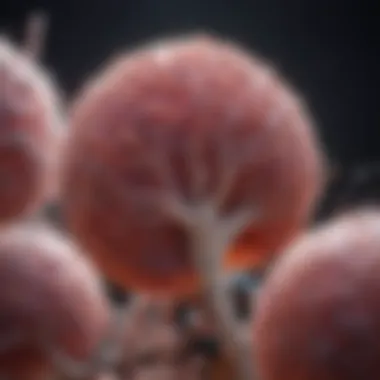Understanding the Causes of Clear Cell Renal Carcinoma


Intro
Clear cell renal carcinoma (ccRCC) is one of the most common kidney cancers, accounting for a significant percentage of renal malignancies. Understanding the causes of ccRCC is crucial for early detection, treatment, and potentially even prevention. This article aims to dissect the intricate web of factors contributing to the emergence of this disease, offering insight into genetic, environmental, and lifestyle components.
Key Concepts and Terminology
Definition of Key Terms
- Clear Cell Renal Carcinoma (ccRCC): A type of kidney cancer characterized by the presence of clear cells in the tumor. It arises from renal tubular epithelial cells.
- Pathogenesis: The mechanism through which a disease develops and progresses.
Concepts Explored in the Article
This article covers several pivotal topics such as genetic predispositions, the effect of environmental factors, and how lifestyle choices may influence the development of ccRCC. Furthermore, it addresses the underlying molecular pathways involved, giving a holistic view of potential risk factors and their interconnectedness.
Findings and Discussion
Main Findings
Recent research highlights several factors that play a pivotal role in the development of ccRCC:
- Genetic Factors: Individuals with a family history of kidney cancer may have a higher risk. Certain genetic mutations, such as those in the VHL gene, are strongly linked to the pathogenesis of ccRCC.
- Environmental Influences: Exposure to specific chemicals, such as cadmium or trichloroethylene, has been shown to elevate the risk of kidney cancer. Moreover, conditions like chronic kidney disease may also foster an environment conducive to cancer development.
- Lifestyle Choices: Smoking is a significant risk factor, along with obesity and hypertension. Diet and exercise also impact kidney health, thus influencing ccRCC risk levels.
Understanding the multifactorial nature of ccRCC causation is vital for advancing research in preventive measures.
Potential Areas for Future Research
There remain gaps in current knowledge surrounding ccRCC. Future research can focus on:
- Interaction effects of genetic predispositions and environmental factors.
- Development of targeted therapies based on genetic profiles.
- Longitudinal studies examining how lifestyle changes can impact ccRCC risk over time.
By comprehensively understanding the causes of ccRCC, researchers may uncover new pathways for intervention and improved patient outcomes.
Prelude
Clear Cell Renal Carcinoma (ccRCC) is a complex disease characterized by specific cellular changes affecting thhe kidneys. It is crucial to explore its causes because understanding these factors can lead to better prevention, diagnosis, and treatment options. This article looks at various influences, including genetic, environmental, lifestyle, and molecular aspects that contribute to ccRCC.
The significance of this topic cannot be understated. ccRCC accounts for the vast majority of kidney cancer cases, and its incidence has been rising. Comprehending the multiple causes of ccRCC not only aids in awareness but also facilitates targeted research aimed at finding effective interventions. By identifying risk factors early, individuals may have a chance for earlier diagnosis and improved outcomes.
Inevitably, a focus on these causes provides valuable insights into the nature of the disease itself, emphasizing how genetics, environment, and personal choices intertwine in the pathogenesis of ccRCC. As we delve deeper into each factor, this article aims to highlight essential elements while ensuring that readers grasp the broader implications of the findings.
Overview of Clear Cell Renal Carcinoma
Clear Cell Renal Carcinoma is notable for its distinct cellular appearance, which is defined by clear cytoplasm in tumor cells. The prevalence of ccRCC has been linked to various risk factors, such as genetic mutations and exposure to certain toxins. It presents chief concerns in the oncological community due to its aggressive behavior and the challenges associated with late-stage detection.
In many instances, patients with ccRCC do not exhibit symptoms until the disease has advanced. Early detection remains limited, highlighting the need for increased awareness and knowledge surrounding the disease. Common symptoms can include blood in the urine, flank pain, and unintended weight loss. However, many of these symptoms are non-specific, making it difficult to identify the disease early. Knowledge of ccRCC allows for a better understanding of its nuances and complexities, crucial for those working in healthcare or research fields.
Importance of Understanding Causes
Research indicates that both inherited and acquired genetic changes play a significant role in the development of ccRCC. Furthermore, environmental factors, such as exposure to chemicals or pollutants, significantly influence disease risk. Lifestyle factors, including obesity and smoking, also contribute to the likelihood of developing renal cancer. A comprehensive understanding of these elements can lead to tailored screening and interventions that could potentially reduce the burden of this disease.
A thorough analysis leads to increased awareness of the risk factors associated with ccRCC, which can inform public health initiatives. Preventive measures can be established and promoted, enhancing early detection tactics and ultimately improving survival rates. By educating the public and healthcare professionals alike, a greater emphasis can be placed on lifestyle choices and environmental safety, which may reduce incidences of this type of cancer.
Genetic Factors
Understanding genetic factors is crucial in the exploration of clear cell renal carcinoma (ccRCC). Genetics play a fundamental role in determining individual susceptibility to this type of cancer. By examining inherited traits, mutations that occur during a person's lifetime, and variations in gene expression, researchers aim to understand predispositions to carcinoma development. This section will discuss the key genetic elements that can influence the onset of ccRCC and emphasize the importance of recognizing these factors for early detection and treatment.
Inherited Genetic Syndromes
Inherited genetic syndromes are conditions passed down through family lines that can significantly increase the risk of developing ccRCC. Notable examples include von Hippel-Lindau (VHL) syndrome, hereditary leiomyomatosis and renal cell carcinoma (HLRCC), and Birt-Hogg-Dubé (BHD) syndrome. Each of these syndromes alters the regulation of cell growth or function, contributing to the risk of kidney tumors.
Individuals with VHL syndrome often develop various tumors, including ccRCC, due to mutations in the VHL gene. Similarly, HLRCC is characterized by mutations in the fumarate hydratase gene, leading to changes in cellular metabolism and promoting tumorigenesis. BHD syndrome involves mutations in the FLCN gene, associated with skin tumors and pulmonary issues, alongside an elevated risk for renal cancer.


Awareness of these syndromes is critical for genetic counseling and screening strategies. Families with a history of these conditions can benefit from proactive monitoring, helping to catch any signs of ccRCC early.
Somatic Mutations
Somatic mutations are genetic alterations that occur in individual cells during a person's life and are not inherited from parents. In the context of ccRCC, specific somatic mutations have been identified that play a key role in tumor development. These mutations can lead to enhanced cell proliferation, survival, and resistance to apoptosis.
A common mutation in ccRCC involves the tumor suppressor gene, particularly in the VHL pathway. Mutations in the VHL gene disrupt its role in regulating hypoxia and angiogenesis, leading to uncontrolled cell growth and a higher likelihood of tumorous development. Besides VHL, mutations in the PIK3CA and TP53 genes also contribute to ccRCC pathogenesis. The PIK3CA mutation affects the cell signaling pathways that promote growth and survival, while TP53 mutations lead to a failure in cellular repair processes.
Somatic mutations are not constant and can vary greatly among individuals. The understanding of these mutations helps in developing targeted therapies that address specific pathways altered in ccRCC biology.
Gene Expression Profiles
Gene expression profiles can provide insights into the biological behavior of tumors and help identify potential therapeutic targets. In ccRCC, specific genes show altered expression patterns that correlate with the aggressiveness of the disease and patient prognosis.
For instance, overexpression of vascular endothelial growth factor (VEGF) is common in ccRCC cases, facilitating angiogenesis and ensuring sufficient blood supply to the tumors. Such findings underline the potential for anti-VEGF therapies in treating ccRCC.
Moreover, gene expression studies often reveal the upregulation of genes associated with metabolic processes and downregulation of tumor suppressor genes. Profiling these expressions can lead to better risk stratification, guiding treatment decisions and monitoring.
By understanding which genes are expressed differently, medical professionals can tailor personalized treatment strategies, enhancing outcomes for patients suffering from ccRCC.
In summary, genetic factors, through both inherited syndromes and acquired mutations, elucidate critical pathways and mechanisms involved in the progression of clear cell renal carcinoma.
Recognizing these genetic influences enables better screening practices and a framework for novel treatment approaches.
Environmental Factors
Environmental factors are important contributors to the risk of developing clear cell renal carcinoma (ccRCC). Understanding these influences can help identify potential pathways involved in the disease’s development. Awareness of environmental risks can lead to preventive measures and healthcare strategies. Moreover, these factors interact with genetic predispositions, compounding their effects. This section discusses how chemical exposures, pollution and toxins, and occupation-related risks contribute to ccRCC.
Chemical Exposures
Exposure to various chemicals has been investigated in the context of ccRCC development. Substances like herbicides, pesticides, and cadmium have been linked to kidney cancer risk. Cadmium, a heavy metal that can stem from industrial processes or dietary sources such as contaminated food, is particularly concerning.
Research indicates that long-term exposure to these chemicals can disrupt cellular processes. Specific investigations suggest that pesticides may alter DNA repair mechanisms and cause mutations conducive to cancer development.
- Examples of chemicals related to ccRCC include:
- Trichloroethylene
- Arsenic
- Asbestos
Recognizing these chemical risks is essential for both individuals and public health policy. Protective measures can help reduce exposure, thus potentially lowering ccRCC incidence.
Pollution and Toxins
Air and water pollutants represent another environmental risk associated with ccRCC. Urban areas often present higher levels of these toxins, possibly due to industrial activities, vehicle emissions, and waste disposal options. Studies have shown a correlation between air pollution and various forms of renal cancer, with particulate matter and nitrogen oxides as significant contributors.
Water pollution also poses a risk, particularly in regions where fertilizers and pesticides contaminate local water supplies. These toxins might lead to chronic kidney inflammation, promoting a favorable environment for cancerous growth. As urbanization increases, understanding the relationship between pollution and ccRCC becomes increasingly urgent.
"Addressing environmental pollution can have a profound impact on community health outcomes."
Effective monitoring and regulation of pollutants could serve as key steps in preventing ccRCC and other health issues.
Occupation-Related Risks
Occupational exposures also play a critical role in ccRCC incidence. Certain professions, especially those involving the handling of hazardous materials, chemicals, and prolonged sitting, are at heightened risk. Workers in industries such as mining, petroleum refining, and agriculture may experience increased exposure to harmful carcinogens.
- Key occupations that show elevated ccRCC risks include:
- Chemical plant workers
- Construction workers
- Healthcare professionals (exposed to certain chemicals)
An assessment of these risks can lead to improved safety measures, workforce education, and health screening policies. Knowing the potential dangers can help mitigate risks associated with these occupations.
In summary, understanding environmental factors is vital for grasping the complexities surrounding ccRCC development. Chemical exposures, pollution, and occupational hazards are pivotal elements shaping the risk landscape of this type of kidney cancer. Efforts towards reducing exposure can lead to beneficial outcomes in both individual and public health.
Lifestyle Factors


Lifestyle factors play a crucial role in the development of clear cell renal carcinoma (ccRCC). Understanding these elements can provide valuable insights into prevention and management strategies. Lifestyle choices, such as diet, exercise, and substance use, have direct implications for renal health. By examining this field, we might uncover possibilities for reducing the incidence of ccRCC through informed lifestyle modifications.
Obesity and Metabolic Syndrome
Obesity is recognized as a significant risk factor for various cancers, including ccRCC. Excess body weight is associated with alterations in insulin, hormone levels, and inflammation, all of which can contribute to tumorigenesis. Individuals with metabolic syndrome, a cluster of conditions that increase the risk of heart disease, stroke, and diabetes, often exhibit higher incidences of ccRCC.
Studies show that obesity can lead to renal cell proliferation and decreased apoptosis, which ultimately facilitates the development of cancerous cells. In addition, obesity-related inflammation may promote cancer progression. Therefore, addressing obesity through lifestyle interventions can be a critical strategy in cancer prevention.
Smoking and Alcohol Use
The connection between smoking and renal cancer is well established. Tobacco smoke contains numerous carcinogens that can cause DNA damage in renal cells. Regular smoking significantly increases the risk for ccRCC. Similarly, excessive alcohol consumption is linked to various cancers, including kidney cancer. Alcohol can act as a solvent, enhancing the absorption of harmful substances and contributing to cellular damage.
Many health organizations recommend minimizing or eliminating smoking and limiting alcohol intake to reduce the overall cancer risk effectively. Educational campaigns focusing on cessation support can provide important tools for individuals seeking to lower their risk for ccRCC.
Dietary Influences
Diet plays an essential role in health and disease, including cancer. A balanced diet rich in fruits, vegetables, and whole grains can enhance overall health and possibly reduce cancer risk. Some studies suggest that specific dietary components can influence the risk of ccRCC. For instance, diets high in red meats and processed foods can correlate with an increased risk in some populations.
Conversely, diets rich in fiber and antioxidants, such as those found in leafy greens and berries, might protect against the disease. Understanding the impact of dietary choices could serve as an effective preventive measure against ccRCC.
Nutrition and lifestyle choices are a form of proactive health management.
Molecular Pathways
Understanding molecular pathways is crucial in comprehending the etiology and progression of clear cell renal carcinoma (ccRCC). These pathways represent complex biological systems that govern cell behavior, growth, and survival. Specific molecular mechanisms can elucidate how ccRCC develops in response to various genetic and environmental factors. With ongoing research, the connection between these pathways and therapeutic interventions becomes increasingly significant. Consequently, a targeted approach based on pathophysiological understanding may enhance treatment efficacy, thus improving patient outcomes.
Vascular Endothelial Growth Factor (VEGF) Pathway
The Vascular Endothelial Growth Factor plays a pivotal role in angiogenesis, which is the formation of new blood vessels. In ccRCC, the VEGF pathway is often overexpressed, leading to increased tumor vascularization. This overexpression is associated with poor clinical outcomes.
Key points about VEGF pathway involvement in ccRCC include:
- Angiogenesis: Tumors require blood supply to grow; VEGF facilitates this by promoting endothelial cell proliferation.
- Metastasis: By enhancing blood vessel formation, VEGF aids in tumor metastasis.
- Therapeutic Targets: Anti-VEGF therapies, like Bevacizumab, have been developed to inhibit this pathway, proving beneficial in treating ccRCC patients.
"Targeting the VEGF pathway has fundamentally changed the treatment landscape for clear cell renal carcinoma."
mTOR Pathway
The mammalian target of rapamycin (mTOR) is a critical protein kinase that regulates cell growth, proliferation, and survival. The mTOR pathway is often activated in ccRCC, leading to enhanced cell metabolism and growth.
Considerations regarding the mTOR pathway in ccRCC involve:
- Cell Growth: mTOR promotes anabolic processes that are essential for cancer cell proliferation.
- Resistance to Therapy: Alterations in this pathway can lead to resistance against standard therapies, complicating treatment regimes.
- Rapamycin Analogs: Drugs targeting the mTOR pathway, like Everolimus, can be effective in managing ccRCC, providing alternative treatment avenues for patients.
p53 Tumor Suppressor Role
The p53 protein is recognized as a vital tumor suppressor in many cancers, including ccRCC. Mutations in the TP53 gene can result in dysfunctional p53, allowing uncontrolled cellular proliferation and tumor progression.
Insights into the role of p53 in ccRCC include:
- DNA Repair: p53 is pivotal in maintaining genomic stability. Defects can lead to increased mutations.
- Apoptosis: It promotes programmed cell death in response to DNA damage. Loss of this function contributes to ccRCC development.
- Role in Therapy: Restoration of p53 function may represent a novel therapeutic approach, providing opportunities for innovative treatments in ccRCC management.
Chronic Kidney Disease Relationship
Chronic kidney disease (CKD) has notable connections with various types of cancer, including clear cell renal carcinoma (ccRCC). Recognizing these relationships deepens our understanding of cancer development and potential intervention points. It is crucial to highlight the mechanisms that link CKD with the onset of ccRCC. This section will focus on specific elements of CKD that increase the risk of developing cancer, along with considerations for awareness and preventive strategies.
Impact of Long-Term Kidney Dysfunction
Long-term kidney dysfunction plays a significant role in the risk of developing ccRCC. Several studies have found that patients with CKD tend to have higher rates of kidney cancer compared to the general population. The underlying reasons are multifactorial.
- Toxicity Accumulation: In CKD, the kidneys cannot effectively filter toxins from the blood. This buildup can create an environment conducive to tumor development.
- Hormonal Changes: CKD alters hormonal levels, particularly those related to the renin-angiotensin system, leading to increased cell proliferation in renal tissues.
- Inflammation: Chronic inflammation associated with CKD may enhance carcinogenic pathways, ultimately promoting the development of malignancies like ccRCC.


Overall, the effects of kidney dysfunction are far-reaching. Acknowledging this relationship is a first step toward improving cancer prevention strategies in individuals with CKD.
Dialysis and Cancer Risk
The relationship between dialysis and cancer risk, specifically ccRCC, is a matter of ongoing research. Patients undergoing dialysis have unique risk factors that can influence cancer development.
- Extended Dialysis Duration: Prolonged exposure to dialysis may increase the risk of ccRCC due to the continuous nature of treatment and the inherent risks it carries.
- Uremic Toxins: Dialysis patients are at risk of uremic toxicity. These toxins can weaken the immune system and promote cancer cell development.
- Altered Immune Response: Dialysis impacts immune function, making patients more vulnerable to infections and possibly cancer.
Endocrine Factors
Endocrine factors play a crucial role in the development and progression of clear cell renal carcinoma. Recent research suggests that imbalances in hormonal levels can influence renal cancer pathways. These factors include hormonal influences and the connection to diabetes mellitus, both of which may increase the risk of developing this specific type of kidney cancer. Understanding how endocrine factors contribute enables researchers and healthcare providers to better target prevention and treatment approaches.
Hormonal Influences
Hormones are biochemical messengers in the body. They regulate numerous physiological processes, including growth, metabolism, and the immune response. In the context of ccRCC, non-optimal hormone levels might promote tumor growth and proliferation.
Several hormones are of interest:
- Androgens and Estrogens: The differentiation in male and female hormone levels could partly explain the sex disparity observed in ccRCC incidence. Elevated androgen levels in men may increase cancer risk, whereas estrogen has protective effects, albeit in different contexts.
- Parathyroid Hormone (PTH): Elevated levels of PTH can interfere with calcium metabolism, potentially fostering an environment conducive to renal carcinogenesis.
- Insulin: Insulin resistance seen in obesity can lead to higher insulin levels, which may stimulate cell growth and proliferation in kidney tissues.
Ultimately, hormonal influences underscore the importance of monitoring hormonal profiles, particularly in patients with risk factors for ccRCC.
Diabetes Mellitus Connection
There is a notable association between diabetes mellitus and the incidence of ccRCC. Individuals suffering from diabetes experience altered metabolic pathways that may predispose them to renal tumors. The connection lies in several aspects:
- Insulin Resistance: Chronic insulin resistance characterizes type 2 diabetes. This condition can cause hyperinsulinemia, promoting cell proliferation and tumor growth.
- Inflammation: Diabetes is linked to systemic inflammation, which can create an environment favorable for cancer development through cytokine release and other inflammatory mediators.
- Metabolic Syndrome: The high prevalence of obesity, hypertension, and dyslipidemia in diabetes contributes significantly to renal cancer risk.
Current Research Trends
Understanding the current research trends in clear cell renal carcinoma (ccRCC) is crucial. Recent developments have enhanced comprehension of this cancer’s biology. Researchers focus on identifying new biomarkers and improving treatment strategies. Knowing these trends helps professionals stay informed about advances that could transform patient care.
Emerging Biomarkers
Recent studies have heralded the discovery of numerous potential biomarkers for ccRCC. These biomarkers could improve diagnosis and predict prognosis. For instance, the identification of HIF-2α as a crucial player in ccRCC development offers insights that could lead to targeted therapies.
Some notable biomarkers under investigation include:
- Vascular Endothelial Growth Factor (VEGF): linked to tumor angiogenesis.
- Programmed Death-Ligand 1 (PD-L1): associated with immune response suppression.
- Nuclear factor kappa B (NF-kB): involved in inflammation and tumorigenesis.
These emerging biomarkers not only hold diagnostic potential but also suggest therapeutic targets. Employing them may lead to personalized treatments, enhancing overall patient outcomes.
Novel Treatment Approaches
As research in ccRCC evolves, innovative treatment options are emerging. These approaches focus on pharmacological agents targeting specific molecular pathways implicated in ccRCC. One such approach utilizes tyrosine kinase inhibitors (TKIs), which block signals promoting tumor growth and spread.
Additional treatment strategies include immunotherapy, particularly immune checkpoint inhibitors that restore the body’s ability to fight cancer. Two prominent agents are:
- Nivolumab: an anti-PD-1 antibody that enhances T-cell activity against tumors.
- Atezolizumab: a PD-L1 inhibitor that may lead to more effective immune reactions.
These treatment modalities signify a shift towards more targeted and less toxic therapies. Ongoing trials are vital in establishing their long-term efficacy and safety.
It is essential for healthcare professionals and researchers to remain engaged with these novel approaches. Staying abreast of research can lead to improved patient outcomes for those afflicted with ccRCC.
The End
Summary of Key Causes
The exploration of the causes of ccRCC highlights several key factors that play a role in its development:
- Genetic Factors: Specific inherited genetic syndromes, such as von Hippel-Lindau disease, and somatic mutations, particularly in the VHL gene, are crucial in predisposing individuals to ccRCC.
- Environmental Factors: Exposure to certain chemicals, environmental pollutants, and occupational hazards significantly increase the risk of developing this cancer. Studies indicate a correlation between pesticide exposure and higher incidence rates among agricultural workers.
- Lifestyle Factors: Obesity and metabolic syndrome have been consistently linked to ccRCC. Additionally, smoking and excessive alcohol consumption are well-established risk factors that exacerbate the likelihood of developing this malignancy.
- Molecular Pathways: Key signaling pathways like the VEGF and mTOR pathways are involved in tumor growth and progression. Understanding these pathways can facilitate the development of targeted therapies.
- Chronic Kidney Disease: Prolonged kidney dysfunction has been associated with an elevated risk of ccRCC. The mechanisms behind this relationship warrant further investigation.
- Endocrine Factors: The role of hormonal influences, particularly in diabetes mellitus, helps to elucidate the connections between metabolic disorders and cancer risks.
Future Directions in Research and Awareness
Research surrounding ccRCC is continually evolving. Ongoing studies are focused on identifying emerging biomarkers that can aid in early detection, leading to improved patient outcomes. Researchers are exploring novel treatment approaches, including immunotherapy and personalized medicine, aimed at targeting the specific genetic and molecular characteristics of ccRCC.
Moreover, raising awareness about the risk factors associated with clear cell renal carcinoma is crucial. Education initiatives should target at-risk populations to encourage lifestyle modifications and regular health screenings.
The integration of findings from basic science with clinical practice may lead to groundbreaking advancements in how ccRCC is managed. Collaborations between healthcare professionals, researchers, and the community will be key in these efforts to reduce the incidence and improve the prognosis of this disease.







